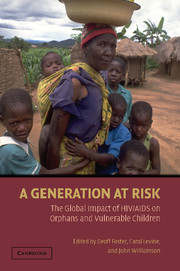Book contents
- Frontmatter
- Contents
- Foreword
- Preface
- Contributors
- Introduction: HIV/AIDS and Its Long-Term Impact on Children
- 1 Family and Community-Based Care for Children Affected by HIV/AIDS: Strengthening the Front Line Response
- 2 Strengthening Households and Communities: The Key to Reducing the Economic Impacts of HIV/AIDS on Children and Families
- 3 The Response of the Educational System to the Needs of Orphans and Children Affected by HIV/AIDS
- 4 Psychosocial Impact of the HIV/AIDS Epidemic on Children and Youth
- 5 Human Rights and Children Affected by HIV/AIDS
- 6 Religion and Responses to Orphans in Africa
- 7 Making the Right Choices in the Asia-Pacific Region: Protecting Children and Young People from HIV and Its Impacts
- 8 Troubled Tapestries: Children, Families, and the HIV/AIDS Epidemic in the United States
- 9 Interventions to Support Children Affected by HIV/AIDS: Priority Areas for Future Research
- 10 Finding a Way Forward: Reducing the Impacts of HIV/AIDS on Vulnerable Children and Families
- Chronology of Important Events
- Resource Guide
- Index
- References
5 - Human Rights and Children Affected by HIV/AIDS
Published online by Cambridge University Press: 05 June 2012
- Frontmatter
- Contents
- Foreword
- Preface
- Contributors
- Introduction: HIV/AIDS and Its Long-Term Impact on Children
- 1 Family and Community-Based Care for Children Affected by HIV/AIDS: Strengthening the Front Line Response
- 2 Strengthening Households and Communities: The Key to Reducing the Economic Impacts of HIV/AIDS on Children and Families
- 3 The Response of the Educational System to the Needs of Orphans and Children Affected by HIV/AIDS
- 4 Psychosocial Impact of the HIV/AIDS Epidemic on Children and Youth
- 5 Human Rights and Children Affected by HIV/AIDS
- 6 Religion and Responses to Orphans in Africa
- 7 Making the Right Choices in the Asia-Pacific Region: Protecting Children and Young People from HIV and Its Impacts
- 8 Troubled Tapestries: Children, Families, and the HIV/AIDS Epidemic in the United States
- 9 Interventions to Support Children Affected by HIV/AIDS: Priority Areas for Future Research
- 10 Finding a Way Forward: Reducing the Impacts of HIV/AIDS on Vulnerable Children and Families
- Chronology of Important Events
- Resource Guide
- Index
- References
Summary
HIV/AIDS epidemics around the world have drastically changed children's lives. Millions of children have been infected with HIV and have died of AIDS, and many more are affected as HIV spreads through their families and communities. The epidemics have an impact on adolescents as well as younger children, and increase the marginalization of children living in particularly difficult circumstances.
To effectively support these children, and to fulfill their potential for growth and development, many approaches are needed: economic, educational, psychosocial, and health care, along with community mobilization. Essential to the effectiveness of these approaches, and as a necessary approach in its own right, is attention to human rights – the focus of this chapter. In November 1989, the United Nations General Assembly approved the first human rights document to focus specifically on the rights of children – the Convention on the Rights of the Child (CRC) (United Nations 1989).
Although the HIV/AIDS epidemics were not a motivating factor in creating the CRC, the document's timing was fortuitous because the devastating impact of the pandemic on the lives of children was becoming more apparent. Within a few years, 191 states signed on to the legal obligations of this document, which became effective in September 1990; today only Somalia and the United States have not ratified it. Some countries have agreed to be bound to the CRC's provisions only insofar as the convention does not contradict their customs and traditions.
- Type
- Chapter
- Information
- A Generation at RiskThe Global Impact of HIV/AIDS on Orphans and Vulnerable Children, pp. 134 - 158Publisher: Cambridge University PressPrint publication year: 2005
References
- 6
- Cited by

